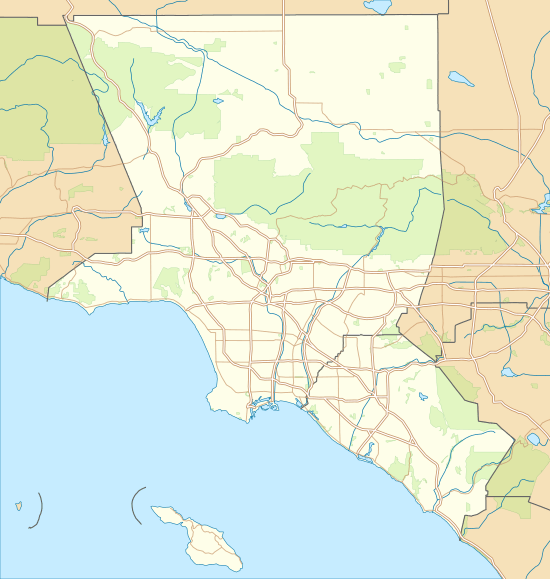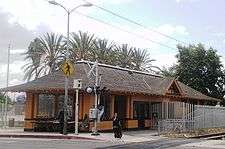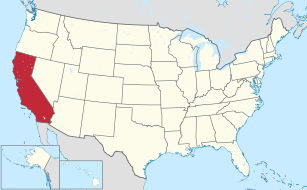Watts Station
Watts Station is a train station built in 1904 in Watts, Los Angeles, California. It was one of the first buildings in Watts, and for many years, it was a major stop for the Pacific Electric Railway's "Red Car" service between Los Angeles and Long Beach. It was the only structure that remained intact when stores along 103rd Street in Watts were burned in the 1965 Watts Riots. Remaining untouched in the middle of the stretch of street that came to be known as "Charcoal Alley", the station became a symbol of continuity, hope, and renewal for the Watts community. It has since been declared a Historic-Cultural Monument and is listed on the National Register of Historic Places.
Watts Station | |
Watts Station, May 2008 | |
   | |
| Location | 1686 E. 103rd Street, Watts, Los Angeles, California |
|---|---|
| Coordinates | 33°56′35″N 118°14′34.80″W |
| Built | 1904 |
| Architect | Unknown |
| Architectural style | Late Victorian |
| NRHP reference No. | 74000523 |
| LAHCM No. | 36 |
| Added to NRHP | March 15, 1974[1] |
Construction and operation as a Pacific Electric station
Watts was built on the old Rancho La Tajuata. In 1902, the family of Charles H. Watts, for whom the community was later named, sought to spur development of the rancho by donating a 10-acre (40,000 m2) site to the Pacific Electric Railway. Watts Station was built on the site in 1904, serving for more than 50 years as a major railway depot and stop for the Pacific Electric's "Red Car" service between Los Angeles and Long Beach. It was located at a major junction, where lines to San Pedro and Santa Ana branched off from the main line to Long Beach. The station is a single-story, 2,200-square-foot (200 m2), wood-frame structure divided into three rooms.[2][3] It was one of the first buildings erected in Watts and is one of the few remaining from its early years.[2] It also served as a model for later depots built in La Habra, Covina and Glendora.[3]
When the station opened, it drew people to the area, so much so that the community that grew in the area was initially known as "Watts Station."
With the Watts junction connecting the Long Beach-Santa Ana line to the San Pedro-Redondo line, Watts was able to secure a working-class population who depended on the “Red Car” service for travel.[4] This service helped the Watts community to continue to grow, with many of its population traveling outside the Downtown area for work opportunities. [5]
The “Red Car” service in Watts Station also allowed for leisure and enjoyment. The population in Watts were not confined to the boundaries of their neighborhoods but free to enjoy the entertainment offered by distant communities, with many using the “Red Cars” to attend nightclubs and dance halls within the larger urban region.[6]
A vintage 1906 photograph of the station from the USC Digital Archives can be viewed here. Another classic image of the station from the collections of the Los Angeles Public Library can be seen here.
The building remained an active depot until passenger rail service was discontinued in 1961.
Effects of its discontinuation
The end of the “Red Car” in Watts brought about change that many often overlook. With its closing, Watts Station lost its only form of transportation, affecting the population in Watts. Many of its low-income residents could also not afford to own automobiles, which were becoming the norm. The spread of employment across Los Angeles and lack of transportation resulted in less employment opportunities and more traveling expenses for the people in Watts.[7]
Colorful and violent history
From its beginning, Watts Station had a colorful and violent history. Incidents occurring around Watts Station in its early years including the following:
- In 1904, shortly after the station opened, a woman described as "an illiterate Mexican woman" was killed trying to save her six-year-old son who had wandered onto the tracks.[8] She was the first person to die in a train accident at Watts Station, and the Los Angeles Times proclaimed her a heroine who "dashed upon the track" and threw her son out of the path of an oncoming train.[8] The paper also noted: "Children are numerous among the Mexican families who live in the vicinity of Watts Station, and with that childish disregard for danger that marks the age of indiscretion these children play on the tracks of the electric railroad."[8]
- In December 1904, a 40-year-old "maiden lady" living at Watts Station deliberately stepped in front of a rapidly approaching Long Beach "flyer." The Los Angeles Times reported that "when the body was finally removed from under the wheels it was so badly crushed and torn that it could hardly be recognized as that of a human being."[9]
- In May 1905, a confrontation at Watts Station prompted a remarkable ethnic commentary by the Times. A man known as the "Duke of Watts" had been hired by the Pacific Electric to watch over the "village of child-like laborers" at Watts station and protect them from "the ways of a wicked gringo world."[10] The "Duke" became angered when wagons driven by "some of thim [sic] damn dagoes" rolled into the right of way raising a cloud of dust. When confronted by the "Duke," who the Times described as "a beneficent sovereign," the paper reported that "one of the Italians went up in the air, the way they do" and the other Italians "jumped down from their wagons and began gesticulating like crazy men, ringing their arms and howling like agitated monkey."[10] The Italians claimed the Duke pulled a large pistol on them and forced them to leave Watts.[10]
- In July 1905, Jose Bustos, "a Mexican employed by the Pacific Electric railway" was struck and almost instantly killed by a Long Beach car at Watts station. After exiting a train, "intending to go to the Mexican camp," he was struck while crossing the south bound tracks.[11] Another Mexican laborer, C. Medal, sustained fatal injuries after being struck by a train at Watts Station six months later.[12] And in December 1906, a motorman, Charles Vaughn, was pinched between two cars at Watts Station, suffering possibly fatal injuries.[13]
- In January 1906, a shooting at Watts Station shocked "Red Car" passengers. A woman named Mrs. Henry Welsh, while in the midst of divorce proceedings, drew a revolver and shot at her husband, who was waiting for the Red Car. When her husband grabbed the gun, Mrs. Welsh walked to her husband's pool room near the station where she "smashed in the windows and generally demolished things."[14] She then secured another revolver and returned to the station, firing two more shots at her husband. Both shots missed her husband and went into a waiting Red Car, sending passengers into a panic.[14]
- In August 1919, a group of ex-employees of Pacific Electric attacked a Red Car at the Watts Station, breaking windows and throwing stones. When A. W. Moon, a Pacific Electric guard, tried to defend the derailed car, he was arrested and charged with "fighting and threatening to fight."[15] The crowd followed the guard to the Watts jail, jeering at him, "calling him opprobrious names," and threatening him. At his trial, it was alleged that the crowd cried, "String them up," prompting Mr. Moon's attorney to request that the case be moved to a venue out of Watts.[15]
Symbol of hope along "Charcoal Alley"

In August 1965, the Watts Riots resulted in the destruction of buildings up and down 103rd Street—the main commercial thoroughfare in Watts. Watts Station was situated in the center of the one-mile (1.6 km) stretch of 103rd Street between Compton and Wilmington Avenue that came to be known as "Charcoal Alley" due to the widespread destruction.[16][17][18] One observer recalled: "Both sides of 103rd Street were ablaze now. The thoroughfare was a sea of flames that emitted heat so unbearable that I believed my skin was being seared off."[19] Another account of the riots along "Charcoal Alley" states: "On the third day of the Watts Riots, 103rd St. was burned to the ground."[20] In the middle of the rubble and widespread destruction along "Charcoal Alley", the Los Angeles Times reported that "the train station was the only structure that remained intact when stores along 103rd Street burned during the Watts riots."[21] The survival of the old wood-framed Watts Station, whether an intentional omission or a mere coincidence, resulted in the station becoming, as the Los Angeles Times put it, "a symbol of continuity, hope and renewal" for the Watts community.[21]
Historic designation and restoration
Four months after the riots, the station was declared a Historic-Cultural Monument (HCM #36) by the Los Angeles Cultural Heritage Commission.[2][22] It was also listed on the National Register of Historic Places in 1974. In the 1980s, after the station had been vacant for many years, the Community Redevelopment Agency spent $700,000 to restore the structure to its original exterior design. The station was re-opened in 1989 as a customer service office for the Los Angeles Department of Water and Power and a small museum of Watts history.[3][21] Mayor Tom Bradley attended the dedication ceremony and said: "Those days of glory are going to return, and we are going to be at the heart of the action right here at the Watts train station."[21]
In 1990, the Metro Blue Line resumed train service from Los Angeles to Long Beach along the old Pacific Electric right of way. Though the old Watts Station does not serve as a passenger platform or ticket booth for the new Blue Line,[21] the trains do stop at a new "Watts Station", 103rd Street-Kenneth Hahn, on 103rd Street, at a location next to the old Watts Station.[23] More than 87 motorists and pedestrians having been killed at Blue Line crossings since 1990,[24] making it the deadliest and most accident-prone light rail line in the country.[25] The Blue Line was renamed to the A Line in 2019.
Watts Station in popular culture
- The 1978 film Killer of Sheep briefly shows small children playing around the Watts Station and abandoned railways.
- Artist Roberto Salas paid tribute to the Red Cars in Watts Station in his public art piece Blue Line Totems in Red.[26]
See also
- List of Los Angeles Historic-Cultural Monuments in South Los Angeles
- List of Registered Historic Places in Los Angeles
References
- "National Register Information System". National Register of Historic Places. National Park Service. April 15, 2008.
- "Watts Station Declared: 'Of Historic Significance'" (PDF). Los Angeles Sentinel. 1965-12-09.
- "Historic Train Depot in Watts Set For $310,000 Restoration". Los Angeles Times. 1986-11-09.
- Avila, Eric (2004). Popular Culture in the Age of White Flight: Fear and Fantasy in Suburban Los Angeles. University of California Press. p. 35. ISBN 9780520939714.
- Avila, Eric (2004). Popular Culture in the Age of White Flight: Fear and Fantasy in Suburban Los Angeles. University of California Press. p. 165. ISBN 9780520939714.
- Avila, Eric (2004). Popular Culture in the Age of White Flight: Fear and Fantasy in Suburban Los Angeles. University of California Press. p. 166. ISBN 9780520939714.
- Elkind, Ethan (2014). Railtown: The Fight for the Los Angeles Metro Rail and the Future of the City. University of California Press. p. 6. ISBN 9780520957206.
- "Dies Awful Death To Save Her Child". Los Angeles Times. 1904-05-19.
- "Ground To Death: Miss Mary Ryan Steps Before Pacific Electric Flyer to Shocking Fate". Los Angeles Times. 1904-12-28.
- "Duke of Watts Was 'Pinched': Scared Italian Grocers Had No Passports; Terrance Mulligan Ordered Them Out of His Dominions, and They Flew to the City to 'Get the Law on Him' - War Busted Loose on the Pacific Electric". Los Angeles Times. 1905-05-14.
- "Stepped to His Death: Laborer Employed by Pacific Electric Killed by Long Beach Car at Watts Station". Los Angeles Times. 1905-07-30.
- "Cannot Recover: Mexican Struck by Car Near Watts Station Sustains Injuries Which Will Prove Fatal". Los Angeles Times. 1906-02-19.
- "Motorman May Die: He Is Pinched Between Two Cars of Work Train at Watts Station; Taken to Hospital". Los Angeles Times. 1906-12-09.
- "Shoots Into Car Window: Woman's Bad Aim Endangers Many Passengers; Mrs. Welsh Fires on Mate at Watts Station; Climax to Numerous Stormy Domestic Quarrels". Los Angeles Times. 1906-01-27.
- "Says He Can't Get Fair Trial: Trolley Car Guard Wants a Change of Venue; Declares Gangsters Menace City Court at Watts; Faces Disturbing of Peace Charge for Doing 'Duty'". Los Angeles Times. 1919-09-16.
- Ray Hebert (1966-02-27). "Hope Brightens for Riot Areas: Action Promises Revitalization of Forgotten Slum". Los Angeles Times. ("In Watts, for example, a mall is being discussed for a stretch of 103rd Street -- the riot's infamous 'charcoal' alley between Compton and Wilmington Ave.")
- Mitchell Landsberg and Valerie Reitman (2005-08-11). "Watts Riots, 40 Years Later". Los Angeles Times. ("They had just secured one of the hardest-hit areas of Watts, a stretch of 103rd Street that had been dubbed 'Charcoal Alley.'")
- Art Berman (1965-12-06). "Watts Scars Heal Slowly: Businessman's New Store Looted". Los Angeles Times. ("Along a mile of 103rd Street in Watts -- dubbed 'Charcoal Alley' after 41 commercial buildings were destroyed by fire during the riot -- block after block is dotted with bare or rubble-filled lots or blackened shells.")
- Betty Pleasant (2005-08-03). "Eyewitness Account of the Watts Riots". The Wave Newspapers.
- "Charcoal Alley". Community Walk.
- Paul Feldman (1989-03-17). "Watts New? Reopening of Historic Red Car Station as Museum and DWP Office Seen as Symbol of Hope, Renewal". Los Angeles Times.
- Los Angeles Department of City Planning (2007-09-07). "Historic - Cultural Monuments (HCM) Listing: City Declared Monuments" (PDF). City of Los Angeles. Retrieved 2008-07-08. Cite journal requires
|journal=(help) - "Blue Line Train Kills Pedestrian at Watts Station". Los Angeles Times. 1999-06-25.
- "Summary of Blue Line Train/Vehicle and Train/Pedestrian Accidents". Los Angeles County Metropolitan Transportation Authority. June 2007.
- "Light rail fatalities, 1990-2002". American Public Transportation Association. 2005-05-20.
- "Artwork | Blue Line Totems in Red". www.metro.net. Retrieved 2018-12-05.

